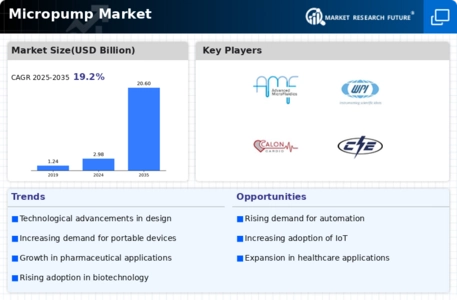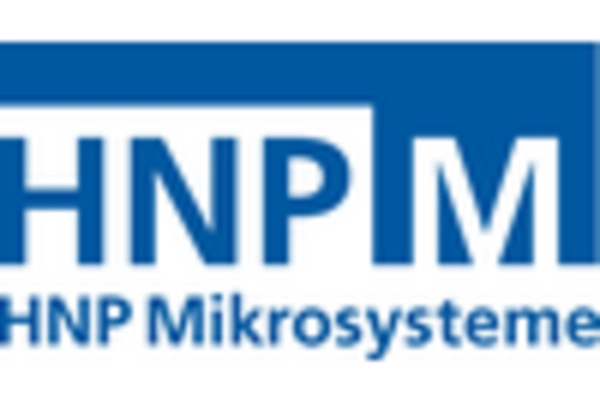-
Introduction
-
Definition 11
-
Scope of Study 11
-
Research Objective 11
-
Assumptions & Limitations 12
- Assumptions 12
- Limitations 12
-
Market Structure 12
-
Research Methodology
-
Research Process 13
-
Primary Research 14
-
Secondary Research 14
-
Market Dynamics
-
Introduction 15
-
Drivers 15
- Material Mix Changes Providing Opportunities for New Players 16
- Increase in Global Demand for Point of Care Testing 16
- Rising Awareness about Importance of Controlled Drug Delivery 17
-
Restraints 17
- Geometrical and Surface Chemistry Issues 17
- Adherence to Stringent Regulatory Requirements 18
-
Opportunities 19
- New Product Innovations 19
- Rise in Partnerships and Collaborations 19
-
Market Factor Analysis
-
Porters Five Forces Model 20
- Bargaining Power of Suppliers 21
- Bargaining Power of Buyers 21
- Threat of New Entrants 21
- Threat of Substitutes 21
- Intensity of Rivalry 21
-
Micro-Pump Market, By Type
-
Introduction 23
-
Mechanical Micro-Pump 24
- Piezoelectric Micro-Pump 25
- Syringe Pump 25
- Peristaltic Pump 25
-
Non-Mechanical Micro-Pump 26
-
Micro-Pump Market, By Industry
-
Pharmaceutical Industry 29
-
Medical Devices 31
-
In Vitro Diagnostics 32
-
Global Micro-Pump Market, By Region
-
Introduction 34
-
North America 35
-
Micro-Pump Market, By Type
-
Micro-Pump Market, By Industry
-
Europe 41
-
Micro-Pump Market, By Type
-
Micro-Pump Market, By Industry
-
Asia-Pacific 52
-
Micro-Pump Market, By Type
-
Micro-Pump Market, By Industry
-
Middle East & Africa 62
-
Micro-Pump Market, By Type
-
Micro-Pump Market, By Industry
-
Company Share Analysis
-
Company Profile
-
Advanced Microfluidics SA 69
- Company Overview 69
- Financial Overview 69
- SWOT Analysis 70
- MRFR Analysis 70
-
Alldoo Micropump 71
- Company Overview 71
- Product/Business Segment Overview 71
- Financial Overview 71
- SWOT Analysis 72
- MRFR Analysis 72
-
Bio-Chem Fluidics 73
- Company Overview 73
- Product/Business Segment Overview 73
- Financial Overview 73
- Key Development 74
- SWOT Analysis 75
- MRFR Analysis 75
-
Cole-Parmer Instrument Company, LLC. 76
- Company Overview 76
- Product/Business Segment Overview 76
- Financial Overview 76
- Key Development 76
- SWOT Analysis 77
- MRFR Analysis 77
-
Dolomite Centre Ltd 78
- Company Overview 78
- Product/Business Segment Overview 78
- Financial Overview 79
- Key Development 79
- SWOT Analysis 80
- MRFR Analysis 80
-
IDEX Corporation 81
- Company Overview 81
- Product/Business Segment Overview 81
- Financial Overview 82
- Key Development 83
- SWOT Analysis 84
- MRFR Analysis 84
-
KNF Neuberger Inc. 85
- Company Overview 85
- Product Overview 85
- Financial Overview 86
- Key Development 86
- SWOT Analysis 86
- MRFR Analysis 87
-
Microfluidica, LLC 88
- Company Overview 88
- Product/Business Segment Overview 88
- Financial Overview 88
- SWOT Analysis 89
- MRFR Analysis 89
-
Servoflo Corporation 90
- Company Overview 90
- Product/Business Segment Overview 90
- Financial Overview 90
- Key Development 91
- SWOT Analysis 91
- MRFR Analysis 92
-
Takasago Electric, Inc. 93
- Company Overview 93
- Product/Business Segment Overview 93
- Financial Overview 93
- SWOT Analysis 94
- MRFR Analysis 94
-
TOPS Industry & Technology Co. Ltd. 95
- Company Overview 95
- Product/Business Segment Overview 95
- Financial Overview 95
- Key Development 95
- SWOT Analysis 96
- MRFR Analysis 96
-
World Precision Instruments 97
- Company Overview 97
- Product/Business Segment Overview 97
- Financial Overview 97
- Key Development 97
- SWOT Analysis 98
- MRFR Analysis 98
-
Xavitech 99
- Company Overview 99
- Product/Business Segment Overview 99
- Financial Overview 99
- Key Development 99
- SWOT Analysis 100
- MRFR Analysis 100
-
List of Tables
-
GLOBAL MICROPUMP MARKET, BY TYPE, 2023-2032 (USD MILLION) 24
-
GLOBAL MECHANICAL MICRO-PUMP MARKET, BY REGION, 2023-2032 (USD MILLION) 26
-
GLOBAL NON-MECHANICAL MICRO-PUMP MARKET, BY REGION, 2023-2032 (USD MILLION) 27
-
GLOBAL MICRO-PUMP MARKET, BY INDUSTRY, 2023-2032 (USD MILLION) 30
-
GLOBAL MICRO-PUMP FOR PHARMACEUTICAL INDUSTRY BY REGION, 2023-2032 (USD MILLION) 30
-
GLOBAL MICRO-PUMP FOR MEDICAL DEVICES INDUSTRY BY REGION, 2023-2032 (USD MILLION) 31
-
GLOBAL MICRO-PUMP FOR IVD INDUSTRY BY REGION, 2023-2032 (USD MILLION) 33
-
GLOBAL MICRO-PUMP MARKET, BY REGION, 2023-2032 (USD MILLION) 35
-
NORTH AMERICA MICRO-PUMP MARKET, BY COUNTRY, 2023-2032 (USD MILLION) 36
-
NORTH AMERICA MICRO-PUMP MARKET, BY TYPE, 2023-2032 (USD MILLION) 37
-
NORTH AMERICA MICRO-PUMP MARKET, BY INDUSTRY, 2023-2032 (USD MILLION) 38
-
US MICRO-PUMP MARKET, BY TYPE, 2023-2032 (USD MILLION) 39
-
US MICRO-PUMP MARKET, BY INDUSTRY, 2023-2032 (USD MILLION) 39
-
CANADA MICRO-PUMP MARKET, BY TYPE, 2023-2032 (USD MILLION) 40
-
CANADA MICRO-PUMP MARKET, BY INDUSTRY, 2023-2032 (USD MILLION) 40
-
EUROPE MICRO-PUMP MARKET, BY COUNTRY, 2023-2032 (USD MILLION) 42
-
EUROPE MICRO-PUMP MARKET, BY TYPE, 2023-2032 (USD MILLION) 43
-
EUROPE MICRO-PUMP MARKET, BY INDUSTRY, 2023-2032 (USD MILLION) 44
-
GERMANY MICRO-PUMP MARKET, BY TYPE, 2023-2032 (USD MILLION) 45
-
GERMANY MICRO-PUMP MARKET, BY INDUSTRY, 2023-2032 (USD MILLION) 45
-
FRANCE MICRO-PUMP MARKET, BY TYPE, 2023-2032 (USD MILLION) 46
-
FRANCE MICRO-PUMP MARKET, BY INDUSTRY, 2023-2032 (USD MILLION) 46
-
UK MICRO-PUMP MARKET, BY TYPE, 2023-2032 (USD MILLION) 47
-
UK MICRO-PUMP MARKET, BY INDUSTRY, 2023-2032 (USD MILLION) 47
-
ITALY MICRO-PUMP MARKET, BY TYPE, 2023-2032 (USD MILLION) 48
-
ITALY MICRO-PUMP MARKET, BY INDUSTRY, 2023-2032 (USD MILLION) 48
-
SPAIN MICRO-PUMP MARKET, BY TYPE, 2023-2032 (USD MILLION) 49
-
SPAIN MICRO-PUMP MARKET, BY INDUSTRY, 2023-2032 (USD MILLION) 49
-
REST OF WESTERN EUROPE MICRO-PUMP MARKET, BY TYPE, 2023-2032 (USD MILLION) 50
-
REST OF WESTERN EUROPE MICRO-PUMP MARKET, BY INDUSTRY, 2023-2032 (USD MILLION) 50
-
EASTERN EUROPE MICRO-PUMP MARKET, BY TYPE, 2023-2032 (USD MILLION) 51
-
EASTERN EUROPE MICRO-PUMP MARKET, BY INDUSTRY, 2023-2032 (USD MILLION) 51
-
ASIA-PACIFIC MICRO-PUMP MARKET, BY COUNTRY, 2023-2032 (USD MILLION) 53
-
ASIA-PACIFIC MICRO-PUMP MARKET, BY TYPE, 2023-2032 (USD MILLION) 54
-
ASIA-PACIFIC MICRO-PUMP MARKET, BY INDUSTRY, 2023-2032 (USD MILLION) 55
-
JAPAN MICRO-PUMP MARKET, BY TYPE, 2023-2032 (USD MILLION) 55
-
JAPAN MICRO-PUMP MARKET, BY INDUSTRY, 2023-2032 (USD MILLION) 56
-
CHINA MICRO-PUMP MARKET, BY TYPE, 2023-2032 (USD MILLION) 56
-
CHINA MICRO-PUMP MARKET, BY INDUSTRY, 2023-2032 (USD MILLION) 57
-
INDIA MICRO-PUMP MARKET, BY TYPE, 2023-2032 (USD MILLION) 57
-
INDIA MICRO-PUMP MARKET, BY INDUSTRY, 2023-2032 (USD MILLION) 58
-
SOUTH KOREA MICRO-PUMP MARKET, BY TYPE, 2023-2032 (USD MILLION) 58
-
SOUTH KOREA MICRO-PUMP MARKET, BY INDUSTRY, 2023-2032 (USD MILLION) 59
-
AUSTRALIA MICRO-PUMP MARKET, BY TYPE, 2023-2032 (USD MILLION) 59
-
AUSTRALIA MICRO-PUMP MARKET, BY INDUSTRY, 2023-2032 (USD MILLION) 60
-
REST OF ASIA-PACIFIC MICRO-PUMP MARKET, BY TYPE, 2023-2032 (USD MILLION) 60
-
REST OF ASIA-PACIFIC MICRO-PUMP MARKET, BY INDUSTRY, 2023-2032 (USD MILLION) 61
-
MIDDLE EAST & AFRICA MICRO-PUMP MARKET, BY REGION, 2023-2032 (USD MILLION) 63
-
MIDDLE EAST & AFRICA MICRO-PUMP MARKET, BY TYPE, 2023-2032 (USD MILLION) 63
-
MIDDLE EAST & AFRICA MICRO-PUMP MARKET, BY INDUSTRY, 2023-2032 (USD MILLION) 64
-
MIDDLE EAST MICRO-PUMP MARKET, BY TYPE, 2023-2032 (USD MILLION) 65
-
MIDDLE EAST MICRO-PUMP MARKET, BY INDUSTRY, 2023-2032 (USD MILLION) 65
-
AFRICA MICRO-PUMP MARKET, BY TYPE, 2023-2032 (USD MILLION) 66
-
AFRICA MICRO-PUMP MARKET, BY INDUSTRY, 2023-2032 (USD MILLION) 66
-
BIO-CHEM FLUIDICS: KEY DEVELOPMENT 74
-
COLE-PARMER INSTRUMENT COMPANY, LLC.: KEY DEVELOPMENT 76
-
DOLOMITE CENTRE LTD: KEY DEVELOPMENT 79
-
IDEX CORPORATION: KEY DEVELOPMENT 83
-
KNF NEUBERGER INC: KEY DEVELOPMENT 86
-
SERVOFLO CORPORATION: KEY DEVELOPMENT 91
-
TOPS INDUSTRY & TECHNOLOGY CO. LTD.: KEY DEVELOPMENT 95
-
WORLD PRECISION INSTRUMENT: KEY DEVELOPMENT 97
-
XAVITECH: KEY DEVELOPMENT 99
-
List of Figures
-
RESEARCH PROCESS OF MRFR 13
-
MARKET DYNAMICS 15
-
IMPACT ANALYSIS OF DRIVERS ON OVERALL MARKET GROWTH 17
-
IMPACT ANALYSIS OF RESTRAINTS ON OVERALL MARKET GROWTH 18
-
PORTERS FIVE FORCES MODEL 20
-
GLOBAL MICROPUMP MARKET, BY TYPE, 2023-2032 (USD MILLION) 24
-
GLOBAL MICRO-PUMP MARKET, BY INDUSTRY, 2023-2032 (USD MILLION) 29
-
GLOBAL MICRO-PUMP MARKET, BY REGION, 2020 (%) 34
-
NORTH AMERICA MICRO-PUMP MARKET SHARE, 2020 (%) 36
-
NORTH AMERICA MICRO-PUMP MARKET, BY TYPE, 2023-2032 (USD MILLION) 37
-
NORTH AMERICA MICRO-PUMP MARKET, BY INDUSTRY, 2023-2032 (USD MILLION) 38
-
EUROPE MICRO-PUMP MARKET SHARE, 2020 (%) 42
-
EUROPE MICRO-PUMP MARKET, BY TYPE, 2023-2032 (USD MILLION) 43
-
EUROPE MICRO-PUMP MARKET, BY INDUSTRY, 2023-2032 (USD MILLION) 44
-
ASIA-PACIFIC MICRO-PUMP MARKET SHARE, 2020 (%) 52
-
ASIA-PACIFIC MICRO-PUMP MARKET, BY TYPE, 2023-2032 (USD MILLION) 53
-
ASIA-PACIFIC MICRO-PUMP MARKET, BY INDUSTRY, 2023-2032 (USD MILLION) 54
-
ASIA-PACIFIC MICRO-PUMP MARKET SHARE, 2020 (%) 62
-
MIDDLE EAST & AFRICA MICRO-PUMP MARKET, BY TYPE, 2023-2032 (USD MILLION) 63
-
MIDDLE EAST & AFRICA MICRO-PUMP MARKET, BY INDUSTRY, 2023-2032 (USD MILLION) 64
-
COMPANY SHARE ANALYSIS 67
-
ADVANCED MICROFLUIDICS SA: SWOT ANALYSIS 70
-
ADVANCED MICROFLUIDICS SA: SWOT ANALYSIS 72
-
BIO-CHEM FLUIDICS: RECENT FINANCIAL 73
-
BIO-CHEM FLUIDICS: OPERATING SEGMENTS 74
-
BIO-CHEM FLUIDICS: SWOT ANALYSIS 75
-
COLE-PARMER INSTRUMENT COMPANY, LLC.: SWOT ANALYSIS 77
-
DOLOMITE CENTRE LTD: SWOT ANALYSIS 80
-
IDEX CORPORATION: RECENT FINANCIAL 82
-
IDEX CORPORATION: BUSINESS REVENUE MIX (2020) 82
-
IDEX CORPORATION: GEOGRAPHIC REVENUE MIX 83
-
IDEX CORPORATION: SWOT ANALYSIS 84
-
KNF NEUBERGER INC: SWOT ANALYSIS 86
-
MICROFLUIDICA LLC: SWOT ANALYSIS 89
-
SERVOFLO CORPORATION: SWOT ANALYSIS 91
-
TAKASAGO ELECTRIC, INC.: SWOT ANALYSIS 94
-
TOPS INDUSTRY & TECHNOLOGY CO. LTD.: SWOT ANALYSIS 96
-
WORLD PRECISION INSTRUMENT: SWOT ANALYSIS 98
-
XAVITECH: SWOT ANALYSIS 100

















Leave a Comment